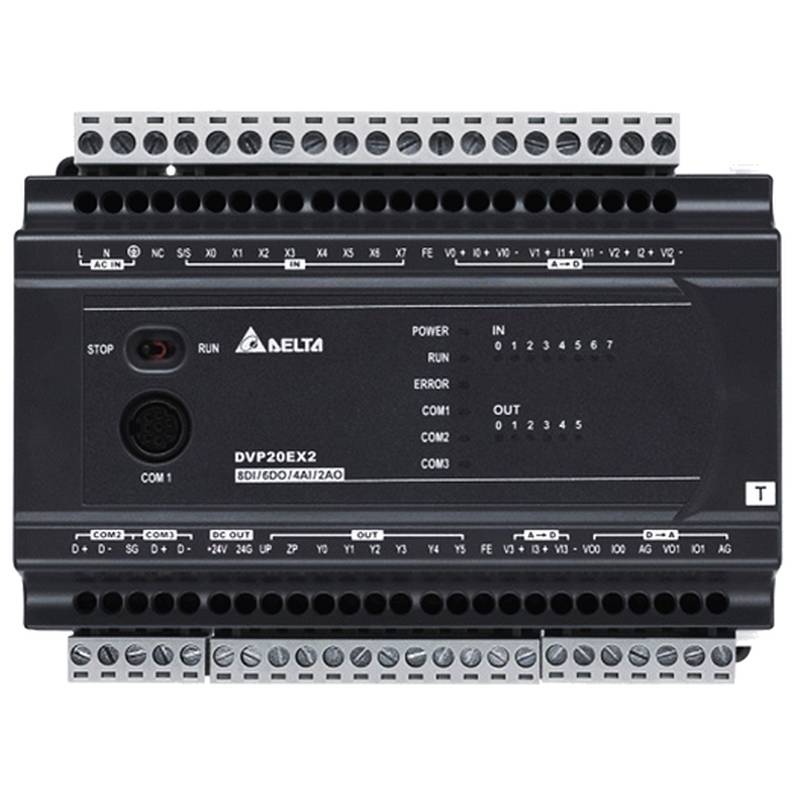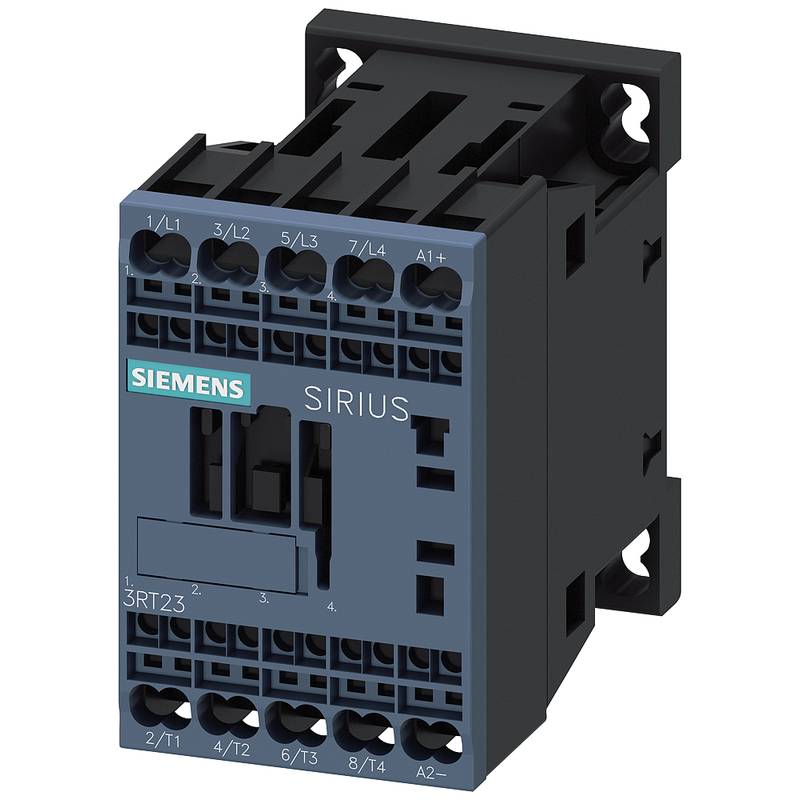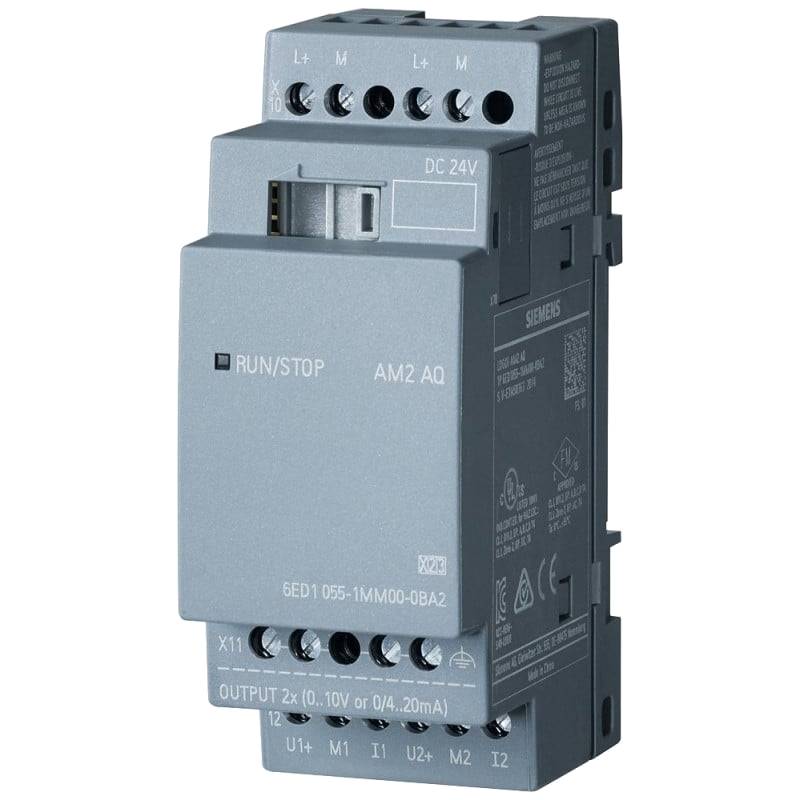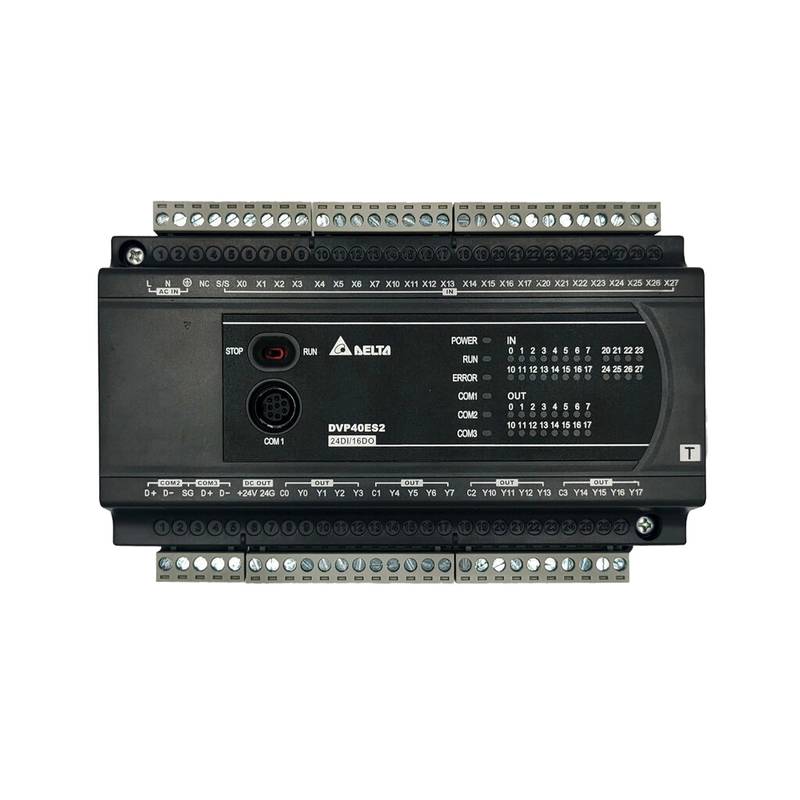
The Delta DVP24ES200R is a high-performance relay output programmable logic controller designed for robust industrial automation. This compact yet powerful unit boasts exceptional processing speed, extensive I/O capabilities, and reliable operation, making it a cornerstone for modern manufacturing and control systems. Key advantages include its cost-effectiveness, ease of integration, and the proven reliability of Delta's DVP series. The controller features a substantial program memory capacity and data registers, enabling complex logic and data handling. Its standard voltage output (100-240VAC) and relay output type ensure broad compatibility with various industrial loads.
Product Specifications
| Feature | Specification |
| :----------------- | :------------------------------------------- |
| Series | DVP-ES2 |
| Model | DVP24ES200R |
| Power Supply | 100-240VAC |
| Output Type | Relay Output |
| Digital Inputs | 14 |
| Digital Outputs | 10 (Relay) |
| Program Capacity | 16K Steps |
| Data Registers | 12K Words |
| Communication Ports| 1 x RS-232, 1 x RS-485 (or RS-422) |
| Max. Instructions | 30,000 |
| Execution Time | 0.3µs (basic instruction) |
| Expansion Modules | Supports various I/O and function modules |
| Operating Temp. | 0°C to 55°C |
Core Features & Market Positioning
The Delta DVP24ES200R stands out in the competitive PLC market due to its blend of performance, affordability, and versatility. Its high-speed execution and ample memory capacity allow for sophisticated control strategies that are often found in more expensive units. The inclusion of two communication ports (one RS-232 and one RS-485/422) facilitates seamless integration into diverse network architectures, supporting protocols essential for industrial communication. This positioning makes it an attractive option for small to medium-sized automation projects where reliability and advanced functionality are paramount without a premium price tag. Delta's reputation for robust industrial hardware further solidifies its market appeal.
Key Application Scenarios
The DVP24ES200R is exceptionally well-suited for a wide array of industrial applications. Its 24 I/O points make it ideal for standalone machines or smaller integrated systems. Common use cases include control of packaging machinery, conveyor systems, material handling equipment, and basic process control loops. It is frequently employed in the food and beverage industry, textile manufacturing, and for controlling HVAC systems in commercial buildings. The relay outputs are advantageous for switching higher AC loads directly, simplifying wiring and reducing the need for external relays in many scenarios.
Practical System Integration Guidance
Integrating the Delta DVP24ES200R into an existing system is straightforward, leveraging Delta's user-friendly programming software, ISPSoft. For wiring, ensure all power sources are de-energized before connecting the 100-240VAC supply to the L and N terminals of the power input. Digital inputs should be connected to the corresponding numbered terminals, observing polarity and voltage requirements. Relay outputs, designated as Y0-Y9, can directly control AC loads up to their rated current and voltage; always use appropriate circuit protection for these loads. For communication, connect devices to the RS-232 or RS-485 ports using standard industrial cabling, paying attention to termination resistors for RS-485 networks to prevent signal reflections.
Operation and Risk Mitigation
Safe operation of the Delta DVP24ES200R necessitates adherence to electrical safety standards. Always ensure proper grounding of the unit and connected equipment to prevent electrical hazards and noise interference. When programming, thoroughly test logic offline before deploying it to the controller to avoid unexpected machine behavior. Common troubleshooting involves checking power supply stability, verifying input signal integrity, and ensuring output relays are not overloaded. Consult the DVP-ES2 Series User Manual for specific error codes and diagnostic procedures; these often point to wiring issues, communication faults, or program logic errors.
Scalability & Long-Term Value
The Delta DVP24ES200R offers significant scalability through its support for various expansion modules. Users can expand digital I/O, add analog I/O, or incorporate specialized function modules like temperature modules or high-speed counters, all connected via the PLC's backplane. This modular approach ensures that the system can grow with evolving production needs without requiring a complete replacement of the central controller. Furthermore, its compatibility with Delta's broader automation ecosystem, including HMI panels and drives, allows for seamless integration into more complex, IIoT-ready solutions for enhanced data acquisition and remote monitoring.
Frequently Asked Questions
What are the primary advantages of the Delta DVP24ES200R?
This PLC offers exceptional cost-effectiveness for its performance capabilities. Its compact design saves valuable panel space in industrial settings. The unit provides robust reliability, a hallmark of Delta's automation products.
It features high-speed processing and ample memory for complex control tasks. The integrated communication ports enhance connectivity options significantly. Relay outputs simplify direct control of AC loads.
Its wide operating voltage range ensures compatibility across different power grids. The extensive range of compatible expansion modules allows for future system growth.
How do I wire the digital inputs on the DVP24ES200R?
Connect your DC sensor or switch outputs to the designated input terminals (X0-X13). Ensure the common terminal for the inputs is correctly wired to the positive or negative DC supply based on your sinking/sourcing configuration. Always verify the input voltage requirement to prevent damage.
For AC inputs, the wiring will differ; typically, one side of the AC signal is connected to the input terminal, and the other is connected to the common. It is crucial to refer to the product manual for specific AC input wiring configurations. Double-check all connections before applying power to avoid short circuits.
Proper wiring ensures reliable signal acquisition by the PLC. Incorrect wiring can lead to intermittent operation or complete failure of input functions. Always follow safety procedures and de-energize the system before making any wiring changes.
Can the Delta DVP24ES200R be expanded with more I/O points?
Yes, the DVP24ES200R supports a wide range of expansion modules. These modules connect to the PLC's side, increasing digital or analog input/output capabilities. You can add modules for specific functions like temperature or high-speed counting.
This modularity allows you to tailor the system precisely to your application's needs. It also provides a cost-effective upgrade path if your requirements change over time. Refer to Delta's compatibility list for specific module part numbers.
Expansion is a key feature for long-term value. It ensures that your automation investment can adapt to future demands without complete system overhauls. Planning for potential expansion from the outset is advisable.
What programming software is used for the DVP24ES200R?
The DVP24ES200R is programmed using Delta's ISPSoft software. This integrated development environment supports multiple programming languages, including Ladder Diagram (LD), Function Block Diagram (FBD), and Structured Text (ST). ISPSoft offers a user-friendly interface for developing, debugging, and monitoring PLC programs.
The software provides simulation capabilities, allowing you to test your logic without connecting to the actual PLC. This significantly reduces commissioning time and potential errors. It also includes tools for managing PLC projects, updating firmware, and performing online diagnostics.
Ensure you download the latest version of ISPSoft from Delta's official website for full compatibility and access to all features. Familiarizing yourself with ISPSoft is essential for effective utilization of the DVP24ES200R's capabilities.
What is the maximum program memory and data register capacity?
The Delta DVP24ES200R features a program memory capacity of 16K steps. This allows for the implementation of complex control algorithms and logic sequences. The controller also comes equipped with 12K words of data registers for storing variables, counters, timers, and other operational data.
This generous memory allocation is a significant advantage for applications requiring extensive data logging or intricate processing. It ensures that the PLC can handle demanding tasks without memory limitations hindering performance. The balance between program steps and data registers is optimized for versatile industrial control.
Understanding these specifications is crucial for system design. It helps engineers determine if the PLC meets the memory requirements of their specific application before deployment. The ample capacity contributes to the PLC's high-performance positioning.
How does the DVP24ES200R handle communication?
The DVP24ES200R is equipped with one built-in RS-232 port and one RS-485 (or RS-422) port. These ports enable communication with other industrial devices such as HMIs, VFDs, sensors, and other PLCs. They support various industrial communication protocols, including Modbus RTU.
The RS-485 port, in particular, allows for multi-drop network configurations, enabling multiple devices to communicate over a single twisted-pair cable. This is highly efficient for supervisory control and data acquisition (SCADA) systems. Proper termination with resistors is necessary for reliable RS-485 communication.
Effective communication is vital for system integration and data exchange. These built-in ports provide a solid foundation for connectivity, reducing the need for external communication modules in many standard applications. Configuration within ISPSoft is straightforward.
What are the typical applications for relay output PLCs like the DVP24ES200R?
Relay output PLCs are widely used for controlling devices that require electrical isolation and can handle higher AC voltage and current loads. This includes switching AC power to motors, solenoid valves, contactors, lights, and heaters. They are common in machine automation, process control, and building automation.
The inherent isolation provided by relays protects the PLC's internal circuitry from voltage spikes and electrical noise generated by inductive loads. This often simplifies wiring compared to DC outputs, as they can switch AC power directly without requiring interface relays for many applications. Their durability and ability to switch significant loads are key benefits.
They are particularly suitable for applications where the controlled device's power requirements exceed the capabilities of transistor outputs. The DVP24ES200R's relay outputs are rated for specific current and voltage limits, which must be observed during system design.
What is the execution speed of the DVP24ES200R and why is it important?
The DVP24ES200R boasts a high-speed execution of basic instructions at 0.3 microseconds. This rapid processing capability is critical for applications requiring precise timing and fast response to changing conditions. It ensures that control logic is executed quickly and consistently, minimizing delays between input detection and output action.
Fast execution speed is vital in high-speed automation tasks like motion control, packaging, or high-frequency signal processing. It allows the PLC to accurately track dynamic processes, react to critical events in real-time, and maintain tight control over machinery. This minimizes errors and optimizes production efficiency.
In industrial environments, even small delays can lead to production losses or safety concerns. The DVP24ES200R's performance ensures that it can keep pace with demanding industrial processes, making it a reliable choice for high-performance automation.
How do I perform an initial setup or commissioning of the DVP24ES200R?
Begin by physically mounting the PLC in a suitable enclosure, ensuring adequate ventilation. Wire the power supply (100-240VAC) to the designated terminals, and connect all field devices (inputs and outputs) according to the wiring diagrams. Double-check all connections for correctness and security.
Next, connect your programming device (PC) to the PLC's communication port (RS-232 or RS-485) using the appropriate cable. Launch ISPSoft, establish communication with the PLC, and download your developed control program. Perform initial diagnostics and a step-by-step test of all I/O and control functions.
Ensure all safety interlocks are functional before initiating full operational testing. Verify that the PLC's operating parameters, such as communication settings and clock settings, are correctly configured. Proper commissioning prevents operational issues and ensures system reliability.
Where can I find the official user manual and technical documentation for the DVP24ES200R?
Official user manuals, technical specifications, and programming software for the Delta DVP24ES200R are available on Delta Electronics' official website. Navigate to the support or download section, typically categorized under "Industrial Automation" or "Products." Search for the DVP-ES2 series or the specific model number (DVP24ES200R).
The manual is an essential resource that details all aspects of the PLC, including hardware specifications, wiring instructions, programming guidelines, communication protocols, and troubleshooting procedures. It also contains important safety information that must be reviewed before installation and operation. Always download documentation directly from the manufacturer's site to ensure you have the most current and accurate information.
Keeping a physical or digital copy of the user manual readily accessible is crucial for ongoing system maintenance, troubleshooting, and future expansion planning. It serves as the definitive guide for all operational and technical queries related to the DVP24ES200R.























